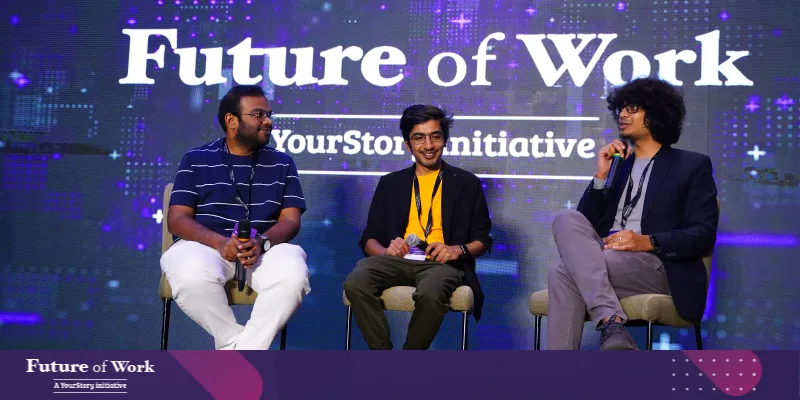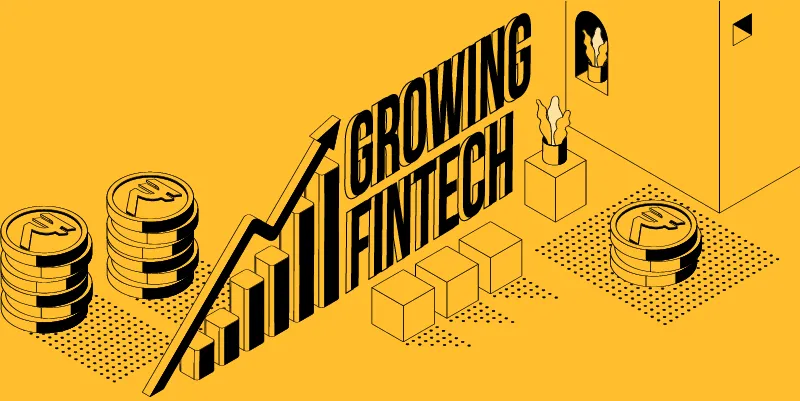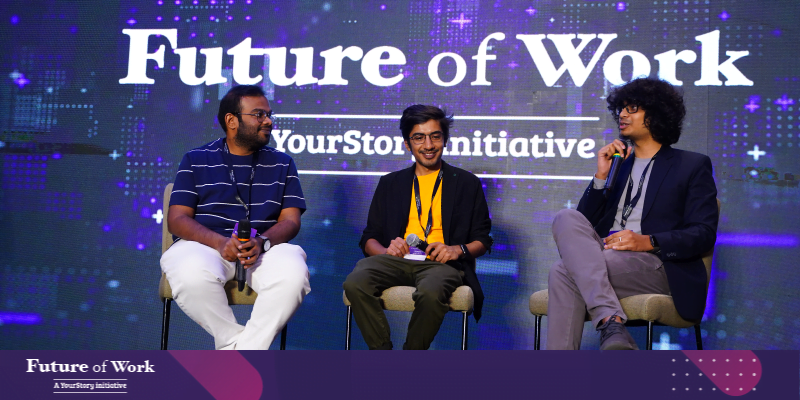On the second day of YourStory’s tech, product, and design conference, Future of Work 2020, three leaders from the Indian startup ecosystem — Chetty Arun, Sidharth, and Dharmesh BA came together to discuss ‘Designing for fintech.’
The trio discussed the regulatory framework and trends in the fintech space, and the limitations of traditional banks.

Regulations as opportunities
Five or six years ago, regulators were generally seen as people who would basically put an end to innovation. But today, a lot of these regulators are actually co-producing products with a lot of fintech players.
“Lot of people consider the regulators to be blockers or the stopping stones for us (fintech companies) to move forward. While regulators are putting in regulations, I also see it as an opportunity. Regulators are opening a lot of space for us to innovate further,” said Chetty Arun, Design Manager at Razorpay. Chetty is a self-taught product designer, and was one of the early hires at Razorpay.
Chetty believes that the Goods and Services Tax (GST) and account aggregators are all creating opportunities in the fintech space. However, sudden regulations have cons too. “When eKYC was introduced for wallets, around 30 percent of the wallets went down in just a month. There are two sides to a coin,” he said.
Dharmesh, Head of D91 Labs and Design Lead at SETU, is equally excited about account aggregators. He believes that a user’s ability to understand and access financial products will be a challenge. However, basic problems like filling bank forms, and getting access to bank statements will be solved by account aggregators. D91 Labs is an open-source initiative by SETU that publishes open-source research, insights, frameworks, and component libraries for fintech companies, to develop digital offerings for India.
Sidharth, Product and Design Head at tourism and leisure startup Headout, on the other hand, believes that regulations like the blanket ban on crypto is not really conducive in a technology development environment. He said that India as a nation is going to miss out on important advancements, as a result of the crypto ban.
“With UPI and NPCI, we are moving towards a more conversational format. I hope people working in the (fintech) industry think well before deciding whether to allow or ban something,” said Sidharth, who has 10-plus years of experience of leading design at product companies.

Trends beyond the metros
Years ago, communication was different from what it is today. Sending a picture across continents was not the trend, but with the intervention of technology and the internet, it is now a matter of a few seconds. Chetty believes a similar change will happen in the fintech space as well.
“Payment is going to be as liquid and common as communication. India is in a space where everyone is consuming the internet. The Jio effect is real — the internet is so cheap nowadays, although the implication is that people are coming online for consuming content. People who are consuming the internet for only communication and entertainment purposes today, are going to transact online,” said Chetty. An alumnus of IIT-Roorkee, Chetty has experience of over nine years. He was previously the Head Designer at SDSLabs.
Sidharth has a similar idea. He said that a decade ago, membership sites and paid blogs were a trend in ‘foreign countries.’ With the introduction of credit cards, trends have changed and now people from even the Tier-II and Tier-III cities are paying for content and services.
Having said that, Sidharth believes that language will be the key to understanding and powering fintech.
“India is not a country where we can keep opening up new bank branches. We have to make it in whichever device is in hand and is capable of doing it. And hopefully, we will cross the language barrier with voice,” said Sidharth, who has also worked as a Product Manager at fintech startup Instamojo.
It was under his leadership that Instamojo scaled its design and core product from 100 to more than six lakh customers. Sidharth is also a Speaker at TED conferences and has previously co-founded UX and Design Agency Mutiny Labs.
Financial inclusion
Speaking about financial inclusion, Dharmesh said that financial inclusion as a journey, starts with a bank account, then payments, followed by investments, and lending, and finally insurance.
“Today, 80 percent of Indian adults have bank accounts, primarily because of the push from the government. However, we still lack the rest of the parameters. Payment is evolving and thus, we have UPI and Google Pay as alternative models. But in case of lending, investments, and insurance, we are still lower as compared to the rest of the emerging nations.
“There is a huge opportunity in the market to intervene and create new products,” he says.
According to Dharmesh, traditional banks have not been able to reach out to lending and investment because financial products were not necessarily designed for these two areas. For example, the minimum amount of loan one could take was probably Rs 1 lakh, and that is almost a year’s income for some.
“Probably the loan they require is Rs 500, and they just require it for a day. This was mostly not a feasible business model for traditional banks,” says Dharmesh, who is building fintech platforms for ‘Bharat.’
Dharmesh was earlier the Lead Product Designer for ClearTax India, and Product Manager at Rupeek. He has done his BTech from Vellore Institute of Technology, before doing his Masters in Design in New Media Design from National Institute of Design.
Dharmesh feels that when it comes to design, there have to be other channels besides mobile apps, like a support system or chatbot like WhatsApp. These features should go hand-in-hand.

Sidharth has a similar opinion. He says, in India’s hinterland, people need small amounts of loan and for a shorter period of time.
“The use case of loans in the FMCG sector is for a day or two, to fulfil the order and have the cash flowing again. The needs of MSMEs are not something that traditional banks can cater to, and banks are clearly not adopting technology,” he says.
Chetty believes that India as a country, has an intent to pay, but affordability plays a huge role and that there is a need for new-age payment methods. The trio further discussed how traditional banks are now starting to co-produce and co-create with fintech players. Chetty said that after having proved its (fintech players) credibility, working with traditional banks has got a lot easier.
Sidharth is of the opinion that going ahead, neo-banks have to either become sales distribution channels for traditional banks or become a bank themselves.
“Do not expect speed, but expect deep innovation in the fintech space,” Dharmesh ends.
[“source=yourstory”]





